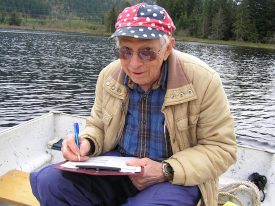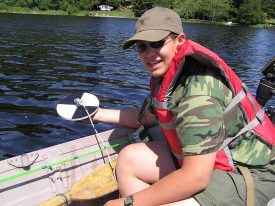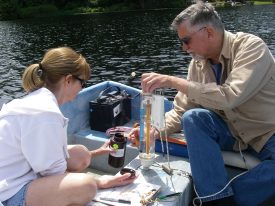by Joy Ramstack Hobbs and Jim Gawel
Lake water quality monitoring is sparse in the state of Washington, and is currently clustered in areas fortunate enough to have a strong county monitoring program. This has been the case since 2000, when the lake monitoring program run by the Washington Department of Ecology (Ecology) lost funding. Although there are several current Ecology programs focused on lakes, including the Freshwater Algae Program and participation in EPA’s National Lakes Assessment, there is no longer an overarching program that collects annual baseline water quality data on Washington lakes.
For several years, WALPA members have advocated for a reinvigoration of lake science throughout the state. Earlier this year, WALPA hired Joy Ramstack Hobbs as a consultant to research successful volunteer monitoring programs in North America and identify success factors and pitfalls. At the same time, WALPA Past-President Jim Gawel brought together lake researchers and educators from Washington’s higher education institutions and other partners experienced with volunteer monitoring programs to discuss what a coordinated lake monitoring program might look like. The group discussed parameters to be monitored, sample analysis logistics, QA/QC needs, and how the data collected would help prioritize lake management and remediation projects. WALPA then convened a meeting of all potential project partners to get their input on and commitment to supporting a lake monitoring pilot program.
The result of these efforts was a grant proposal submitted on October 16th to Ecology’s Water Quality Financial Assistance program (Clean Water Act Section 319 Program) to fund the Washington Community Allied Lake Monitoring (CALM) pilot program. WALPA proposes to partner with state public universities, natural resource agencies, and other stakeholders to create a state-wide volunteer monitoring program to increase public usability and improve long-term lake health.
This three-year pilot program would create a collaborative, robust, and expandable structure for executing a state-wide program. The higher education institutions actively involved are University of Washington (Tacoma, Seattle, and Bothell), Washington State University (Pullman and Vancouver), Western Washington University, and Central Washington University, with additional institutions interested in future involvement. State and county agencies partnering and committed to providing guidance include the Washington Departments of Ecology, Natural Resources, and Fish and Wildlife; Washington State Parks; King and Snohomish Counties; Pierce Conservation District; and Tacoma-Pierce County Health Department.
Working with all partners as an advisory council, the proposal names 24 lakes to monitor in 3 regions (East, Central, and West), roughly aligned with lake density and partner universities. Priority was given to lakes with documented water quality or invasive species problems that threaten public usability (as identified by agency partners), but that are not currently funded for monitoring and outreach.
If this proposal is funded, a Program Coordinator will be hired. Under WALPA and University of Washington Tacoma (UWT) direction (UWT is the project and fiscal lead for this proposal), the Program Coordinator will recruit and train volunteers for target lakes, develop quality assurance procedures, coordinate sample collection and analysis, perform QA/QC and disseminate data to volunteers and state databases, lead program assessment, and lay the groundwork to acquire permanent funding.
Designated faculty members at partner universities will act as regional contacts for volunteers from area lakes, and will recruit students to help with outreach, training, and sampling. The regional contacts, communicating with the Program Coordinator, will provide regular check-ins with volunteers, answer questions and act as nearby project liaisons, meet once a summer to help volunteers collect vertical profiles and sample project parameters in their lake, and act as a collection center for samples being sent out for analysis.
Monitored parameters for the pilot program will focus on two state priorities: harmful algae blooms (HABs) and invasive species. Volunteers will conduct monitoring once a month from May-September. Parameters sampled will include: Secchi depth, total phosphorus (TP) in surface water, invasive shellfish presence (Asian clams, zebra and quagga mussels, and New Zealand mudsnails), HAB occurrence, and other observational data (e.g., waterfowl counts, lake user type/number, Forel-Ule water color, ambient noise).
Once a year in August, when water quality is usually at its worst, regional contacts will work with volunteers to collect vertical profile measurements of temperature, dissolved oxygen, conductivity, pH, TP, and chlorophyll. TP samples will be preserved and transported by volunteers or students to the regional university, consolidated, and sent to Western Washington University’s Institute for Watershed Studies (a state certified lab) for analysis. Chlorophyll samples will be sent to University of Washington Tacoma for analysis. If HAB scums are detected, samples will be sent to King County for analysis through their existing program.
Lake selection, quality assurance development, outreach and education planning, and program assessment will be informed by an advisory council of representatives from state and county partner agencies. Partner involvement will ensure relevance of project lakes, defensible data/sample collection methods, access to and advice on BMPs and public education materials to share with lake residents and users, constructive use of collected data, and mid-term and final assessment of the overall program.
The Department of Ecology expects to issue a draft funding list for this round of proposals in mid- to late-January, and a final funding list in June. Thank you to everyone who contributed to this large collaborative effort!













